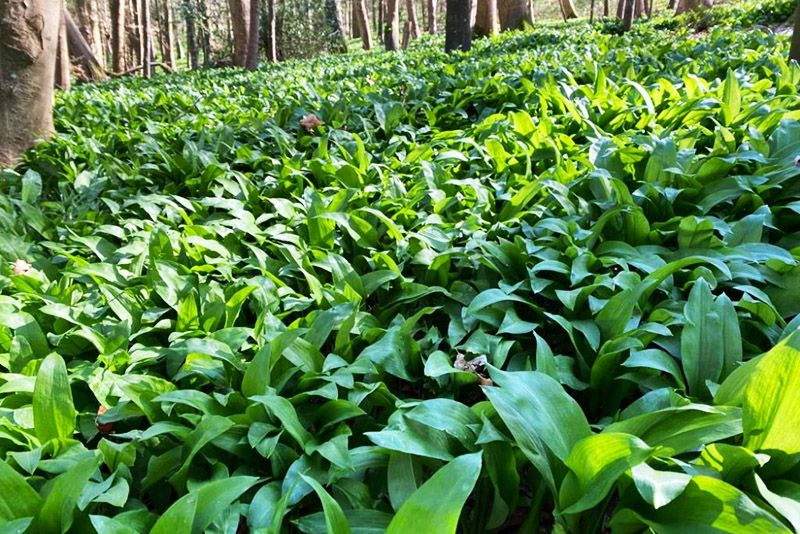Introduction:
From the foothills of the Caledonia forest to the Eurasian plains, this wild plant has a fascinating history that spans various cultures around the world. In this blog post, we’ll explore the origins and historical uses of wild garlic, shedding light on its global significance.
Wild garlic (Allium ursinum) is a perennial herb native to Europe and parts of Asia. Also known as Ramsons, ramps, or bear’s garlic, it is a versatile herb that has been cherished for its culinary and medicinal properties for centuries. The plant’s scientific name, “ursinum,” meaning “bear” in Latin, is derived from the belief that bears consume it to rejuvenate and regain their strength after hibernation. This association with restoration and purification stems from the bears critical need for nutrients after a long period of deficiency, using up vital stores during hibernation.
As cultured omnivores, bears are believed to have superior knowledge of plants and foods, from which humans would often took guidance in prehistoric times. Allium ursinum is known colloquially as bear garlic, bear leek or bear onion across at least 20 European languages, including Hungarian, Turkish, Ukranian, Polish, Italian, German, Serbo-Croat, Russian, Estonian, Danish and Albanian (Kolosova et al., 2017). The association is an old one, as the plant was first given the name “bear’s onion” by the ancient Greeks (Kolosova et al., 2017)
Western Europe:
Wild garlic has deep roots in European cuisine and folklore. The English naturalist William Turner recorded its presence in 16th-century England, where it was known as “ramsons.” This remarkable plant has a deep historical connection with the English countryside. In 1548, the English naturalist William Turner referred to it as “ramsey,” “bucrammes” (buck rammes), and “rammes.” Several places in England bear its name, such as Ramsbottom (meaning ‘Ramson valley’) in Lancashire and Ramsey (meaning ‘Ramson island’) in Essex and Huntingdonshire.
The name “ramsons”, comes from the Saxon word “hramsa” but there is evidence that use of this plant is far older, as charred remnants of wild garlic bulbs were discovered at a late Mesolithic settlement in Denmark. It was known to the early Celts and ancient Romans, who allegedly referred to it as “herba salutaris” – the healing herb.
The medicinal properties of wild garlic were well-documented by the Greek physician Dioscorides (c. AD 40-90), who recognized its detoxifying qualities. Even the Emperor Charlemagne (AD 747 – 814) acknowledged its significance, including it in his directory of medicinal plants, known as the Capitulare de Villis imperialibis (Sobolewska et al., 2015).
Faith in wild garlic’s general health benefits was also preserved in the old English proverb:
Eat leeks in Lide [March] and ramsons in May
And all the year after the physicians may play
In ancient Ireland, it was a cherished staple of salads, soups, and stews. Traditionally it was used to flavour butter in place of salt. In Irish folklore, wild garlic had a protective role, deterring fairies when planted in the thatch of cottages. It also featured in Irish legends, such as the story of Mad Sweeney, a king who survived in the wild by consuming plants, including wild garlic.
The Old Irish Brehon laws even imposed fines for stealing wild garlic from private land, highlighting its value as a source of food and medicine.
John Gerard, an English herbalist in the 16th century, prescribed wild garlic as an early cure for kidney stones. While The Physicians of Myddfai, a group of herbalists in Wales around the 13th century, used wild garlic for its diaphoretic, diuretic, expectorant, and antiseptic qualities.
Modern research has lent credence to this folk wisdom. Wild garlic has been found to possess antimicrobial, cytotoxic, antioxidant, and cardio-protective properties (Sobolewska et al., 2015). It shows particular promise in addressing cardiovascular diseases and is recognized for its wound-healing abilities. These benefits are attributed to the presence of sulfur-containing compounds, common to alliums, which also give wild garlic leaves their distinctive garlic aroma. Studies on rats have shown that wild garlic has cardio-protective effects, reducing blood pressure, lowering cholesterol synthesis, and decreasing plasma ACE activity (Rietz et al., 1993; Preuss et al., 2001). Additionally, a component of wild garlic’s volatile oil, diallyl disulfide, has demonstrated the ability to inhibit the proliferation of human cancer cells, including those associated with breast, lung, colon cancers, lymphomas, and neuroblastomas (Lai et al., 2012).
Conclusion:
Wild garlic, with its captivating history and diverse cultural uses, remains a culinary treasure. From ancient medicine to modern cuisine, it has maintained its place as a symbol of spring and a source of nourishment. Whether enjoyed in soups, as a pesto, or dried, ground and sprinkled over your favourite dish, wild garlic is a testament to the enduring connection between humans and the natural world. So, the next time you encounter these vibrant green leaves in the wild, remember the rich tapestry of history that accompanies them


